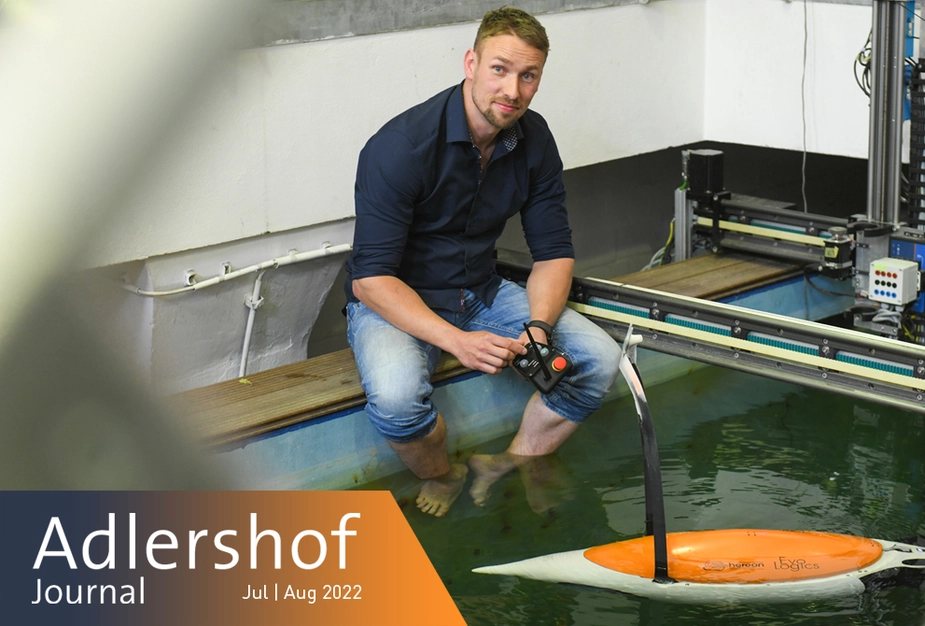From dolphin sounds to underwater internet
EvoLogics looks towards animal role models for its autonomous diving robots
A new headquarters is being built on Adlershof’s Wagner-Régeny-Straße. It belongs to a high-tech company that connects underwater infrastructures in oceans, rivers, and lakes, and develops autonomous robots reminiscent of penguins and manta rays for environmental monitoring of deep-sea mining and offshore wind farms as well as for climate research. And looked at dolphins to understand how signals travel long distances in water with little interference.
We don’t know whether the pike in Lake Werbellin are still talking about the recent sighting of manta rays. Fabian Bannasch, however, CEO of EvoLogics GmbH, saw it with his own eyes. In fact, it was his very own school of bionic underwater robots. Artificial rays equipped with a range of sensors that glide across the bottom of the lake with gentle wing strokes and can safely navigate even the most rugged topographies. The company’s other type of underwater robot is based on the evolutionarily optimised body shapes of penguins, turtles, and dolphins. Not only their shape, but also their mode of underwater communication is bionically inspired.
Himself a passionate diver, when Bannasch talks about EvoLogics and its global projects, it's easy to dive right in with him. Founded at the turn of the millennium, the company’s technology has helped to recover ammunition from the North and Baltic Sea. It is also used for underwater data transmission for tsunami warning systems in Southeast Asia. Climate research teams send EvoLogics’ sensor-heavy penguins on underwater formation flights through water swirls and ocean currents to record water movement based on salinity and temperature. Environmental agencies use the company’s sensors to monitor the water quality of rivers. The above-mentioned mantas are now being prepared for deep-sea expeditions, where they will chaperone the devices used for harvesting manganese nodules on the sea floor and to identify and protect ecologically sensitive areas. Other robots monitor underwater infrastructure in the oil and gas industry or the foundations in offshore wind farms. Operators of fish farms in oceans and lakes use EvoLogics’ technology to help them control and maintain their underwater facilities. Lastly, the company’s sensor, positioning, and AI-supported object recognition technology is used for recovering drowned and wrecked cars in canals and rivers.
What is just briefly summarised here is told by Bannasch in fact-rich anecdotes from the many deployments with about 500 customers from research and industry from 63 countries. Things get increasingly lively whenever dolphins are mentioned. Not only is Bannasch fascinated by their skills and communication, he and his team have researched them in great detail and based their own underwater communication technology on these findings. “Since radio waves don’t transmit through water, we looked at acoustic data transmission,” he says. Sound travels further there but is reflected in many places or scattered by temperature layers. This creates a complex cacophony of signals in the oceans. Acoustic transmission, too, has its limits, especially in shallow waters and ports. “Interestingly, dolphins do not have these problems. They can communicate across a distance of 10 kilometres and coordinate their hunts,” he says. At the same time, their sonar system is so sensitive that the animals can distinguish between different types of steel. EvoLogics modulates the characteristics of the dolphin signals in the underwater modems to achieve unprecedented data and communication quality.
“To do so, we require much less transmission energy than previous communication systems. While high-energy sonars contribute to beaching whales, our modems attract curious dolphins that want to play with them,” he says.
Transmitting the measurement data from underwater robots is crucial. Evologics couples the technology with high-precision geopositioning. For this purpose, a GPS buoy sends reference values into the deep, which are then used to determine the exact position of the floating sensor systems. This technology is also in demand for surveying marine construction sites.
All this technology and a growing group of global customers are adding to the company’s robust growth. The staff has grown to 55 employees “with inquiring minds and a penchant for high-tech play,” says Bannasch. To ensure that they have a place to play these out in the future, EvoLogics is now building a new high-tech headquarters in Adlershof. It will have water basins, a pond, laboratories, and a pressure tank, which will be used to test robot expeditions in a water depth of 6,000 metres. Instead of steel-armoured pressure chambers, the team uses delicate, water-filled structures with self-developed sensor skins. Soon, up to 150 employees will be working on this smart ocean-based technology. “We have designed the new headquarters with this in mind,” he says, “because the technology that we have been developing for two decades is in more demand than ever.” The digital development of underwater worlds is only just beginning.
Despite the testing pools on Wagner-Régeny-Straße, Bannasch and his team will continue to use Brandenburg’s lakes for testing. The local pike will have to get used to more unusual visitors.
Peter Trechow for Adlershof Journal
